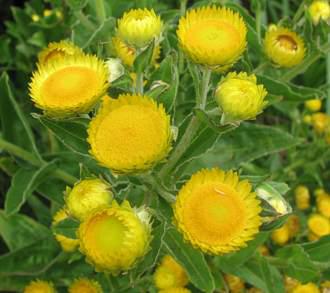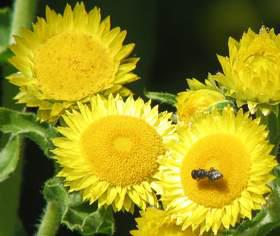Helichrysum cooperi
Helichrysum cooperi Harv.
Family: Asteraceae
Common names: yellow everlasting (Eng), geelsewejaartjie (Afr.), bohloko, phefo-ae-thaba, toane-balimo, toane-balingoana (South Sotho), umadotsheni (Zulu)
Introduction
This biennial aromatic herb grows in grassland, often near or on forest margins in the Free State, Mpumalanga, Kwazulu-Natal and Lesotho. The plant's most attractive feature are its bright golden yellow flowers.

Description
Description
Helichrysum cooperi is a fast-growing biennial herb up to 1.5 m high. In young plants the leaves are crowded in an almost whorl-like arrangement but as the plants grow older the alternate leaf arrangement becomes apparent. The leaves are simple, oblong, net-veined and have an entire margin. They are light green and sticky with a covering of tiny hairs. The bottom leaves become dry when the plants grow older. The fresh leaves produce an aromatic smell when crushed between the fingers. Plants start to flower from early January until late March and produce many bright golden yellow flowerheads arranged in a large spreading leafy inflorescence. The flowerheads are shallowly cup-shaped and contain about 1000 tiny florets. When mature the flower heads close and become dry. They produce many very fine 'seeds' (fruits) about 1 mm long containing a single seed. At their top the 'seeds' have a tuft of fine bristles.
Conservation Status
Status
Helichrysum cooperi is not listed in the Southern African plant Red Data Lists.
Distribution and habitat
Distribution description
Helichrysum cooperi grows in the Free State, Kwazulu-Natal, Mpumalanga and Lesotho. The species is found in grassland in full sun; it loves moist conditions and often grows near or on forest margins.
Derivation of name and historical aspects
History
The genus Helichrysum was named by Philip Miller (1691-1771), a British gardener, who was superintendent of the Chelsea Physick Garden of the Society of Apothecaries from 1722 to 1770. The genus name Helichrysum comes from the Greek words helios, meaning sun, and chrysos, meaning gold. Most species of this genus have golden yellow flowers. According to Elsa Pooley (1998) the specific epithet honours Thomas Cooper, 1815-1913, an English plant collector and cultivator who came to South Africa in 1859.
Ecology
Ecology
The flowers of Helichrysum cooperi attract many small insects like bees, flies and beetles which pollinate them when moving from one to the other. Seed dispersal is by water or wind. The leaves may hold the seed (fruit) with their sticky surface thus preventing them from being blown away by the wind.

Uses
Use
Helichrysum cooperi is used as a love charm by the Zulus. The dry leaves are mixed into an ointment which is applied all over the body after the bath. As a result the desired lady finds the man irresistable. From a horticultural point of view Helichrysum cooperi is a good fill-in plant with its bright golden yellow flowerheads which may be produced for more than three months.

Growing Helichrysum cooperi
Grow
The seeds may be sown fresh or may be stored to be sown in summer time. Mix 50% sand or silica sand with 50% seedlings mixture. The sand ensures good drainage. The seeds can be mixed with the soil cover or can be sown first and then covered with very fine soil. The container needs to be watered by standing it in water to just below the rim or it may be placed under mist irrigation; but avoid too much moisture. The seeds will germinate within about three weeks. After two weeks of hardening-off the plants may be transplanted into 2 litre bags. Pinch the top to get a bushy plant. The plants may be planted in the display bed 30 cm apart to produce a dense display. They thrive in full sun and must be kept moist at all times.
References
- Arnold, T.H. & de Wet, B.C. 1993. Plants of Southern Africa: names and distribution. Memoirs of the Botanical Survey of South Africa No. 62.
- Germishuizen, G. & Meyer, N.L. 2003. Plants of southern Africa: an annotated checklist. Strelitzia 14. National Botanical Institute, Pretoria.
- Golding, J.S. (ed.) 2002. Southern African plant Red Data Lists. Southern African Botanical Diversity Network Report No. 14.
- Hilliard, O.M. 1983. Asteraceae. Flora of southern Africa 33, 7, 2 (First part).
- Pooley, E. 1998. A field guide to the wild flowers of Kwazulu-Natal and the eastern region. Natal Flora Publications Trust.
- Pooley, E. 2003. Mountain flowers. A field guide to the flora of the Drakensberg and Lesotho. The Flora Publications Trust.
- Smith, C.A. 1966. Common names of South African plants. Memoirs of the Botanical Survey of South Africa No. 35.
- Watt, J.M. & Breyer-Brandwijk, M.G. 1962. The medicinal and poisonous plants of southern and eastern Africa. Livingstone, Edinburgh and London.
Credits
Luambo David Rambuwani
Free State National Botanical Garden
February 2009
Plant Attributes:
Plant Type: Bi/Annual
SA Distribution: Eastern Cape, Free State, KwaZulu-Natal, Mpumalanga
Soil type: Sandy
Flowering season:
PH:
Flower colour: Yellow
Aspect: Full Sun
Gardening skill:
Special Features:
Horticultural zones









Rate this article
Article well written and informative
Rate this plant
Is this an interesting plant?
Login to add your Comment
Back to topNot registered yet? Click here to register.